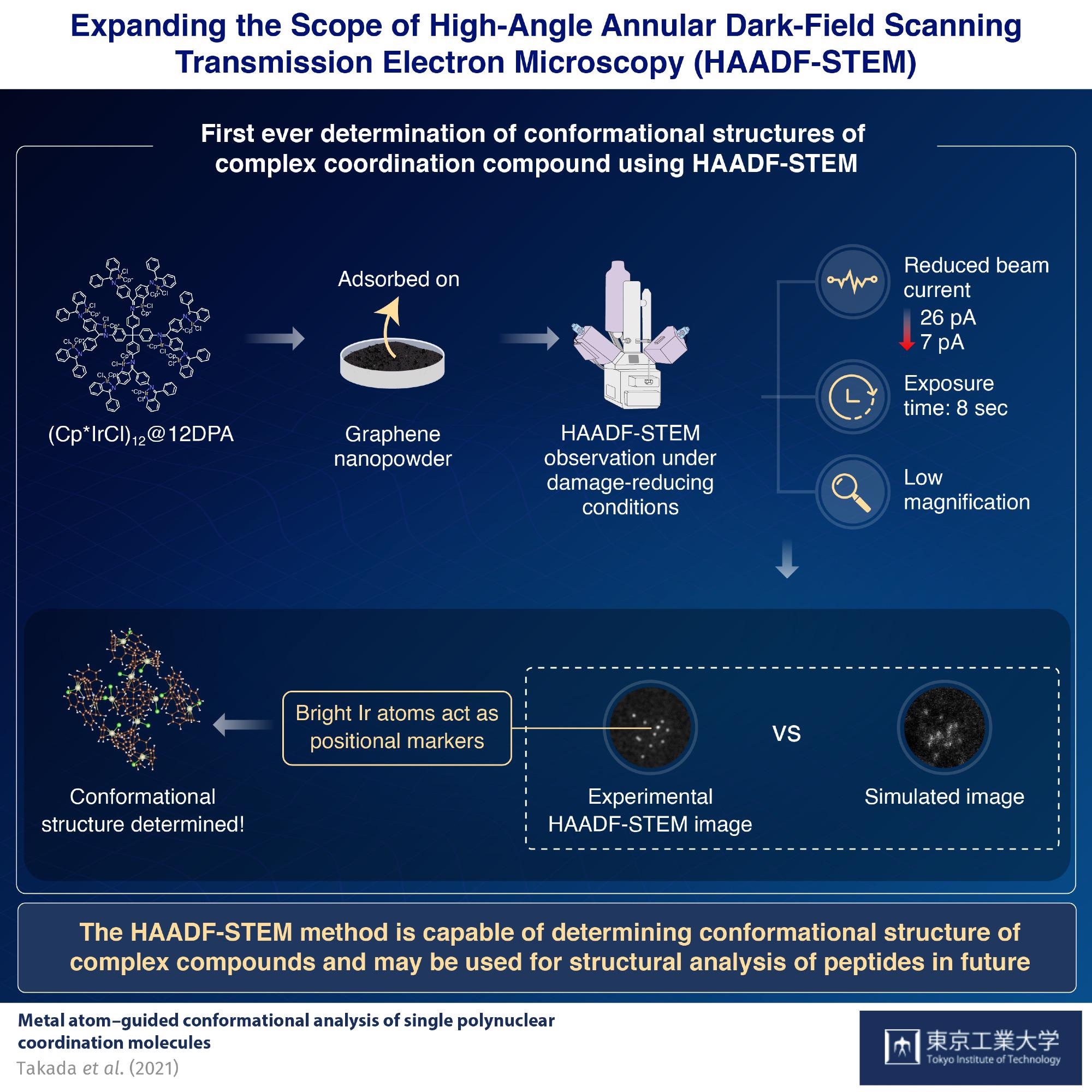High-angle annular dark-field scanning transmission electron microscopy can be used to determine complex conformational structures of both crystalline and amorphous polynuclear non-planar coordination molecules, as shown by scientists from Tokyo Institute of Technology (Tokyo Tech). Using iridium as a tracer metal, they were successful in determining the different conformations of a highly branched coordination compound molecule. This has opened up possibilities for imaging and designing of complex inorganic and organic molecules.

Image Credit: Tokyo Institute of Technology
Coordination compounds have molecular structures which consist of either one or multiple metal atoms at the center, surrounded by non-metal atoms. Their fascinating physical and chemical properties, which have significant applications in material science, depend largely on their molecular structure. Thus, a definitive analysis of their molecular structure is necessary not only for understanding their properties, but also for designing specific coordination compounds with targeted functions.
Though several analytical methods are available for structural determination of coordination compounds, they each have their own limitations. For example, X-ray crystallography can only determine the structure of crystalline compounds, while nuclear magnetic resonance cannot provide accurate results when paramagnetic atoms are involved. A more recent microscopy technique, high-angle annular dark-field scanning transmission electron microscopy (HAADF-STEM), that has revolutionized the field of molecular imaging with real-time visualization of single coordination molecules, is also limited to observation of simple and planar molecules. Hence, the structural determination of various conformations (all possible spatial orientations of atoms) of both crystalline and amorphous polynuclear coordination molecules remains unexplored.
To bridge this gap, a team of researchers from Tokyo Institute of Technology, led by Professor Kimihisa Yamamoto and Associate Professor Takane Imaoka, have developed a novel imaging method using a metal-atom tracer in HAADF-STEM to determine the conformational structures of complex and highly branched polynuclear coordination compounds. Their findings are published in Science Advances.
Using iridium as a metal tracer, because its high atomic number (Z=77) will provide better visualization with HAADF-STEM, we synthesized iridium fixated dendritic phenylazomethine (DPA) compounds. Then, we determined the optimum operating conditions for HAADF-STEM, under which the different conformations of these highly branched DPA compounds could be determined with the highest accuracy.
Imaoka Takane, Associate Professor, Institute of Innovative Research, Tokyo Institute of Technology
To determine the optimum operating conditions for HAADF-STEM, the researchers observed samples of iridium-DPA compound, dispersed on the surface of graphene nanopowder, under a variety of operating conditions. They found that reducing the beam current to 7 pA and exposure time per pixel to 8 microseconds and using low magnification helped reduce the damage to the iridium-DPA compound and allowed the successful observation of its structure. The iridium atoms appear as bright spots in the HAADF-STEM images, indicating their position in the structure of the molecule.
Once the HAADF-STEM image of the iridium-DPA molecule was obtained using the optimum conditions, the researchers compared it to simulated images of all possible conformations of the molecule to find the closest match. The structures captured in the experimental HAADF-STEM images fit extremely well with the simulated conformational structures. Thus, the most accurate conformational orientation of a molecule can be easily determined by comparing HAADF-STEM and simulated images.
The potential applications of this heavy metal guided HAADF-STEM technology are not only limited to structural analysis coordination compounds.
Our study is a pioneering effort in imaging conformational structures of complex macromolecules. As this technology is effective for both crystalline and amorphous compounds, we believe this technology can also be applied for determination of structures of multinuclear peptides through complexation with tracer metal atoms, and work on this area is already under progress.
Imaoka Takane, Associate Professor, Institute of Innovative Research, Tokyo Institute of Technology
Reference
Authors: Kenji Takada1, Mari Morita1, Takane Imaoka1,2, Junko Kakinuma1, Ken Albrecht1,2, Kimihisa Yamamoto1,2
Title of original paper: Metal atom–guided conformational analysis of single polynuclear coordination molecules
Journal: Science Advances
DOI: https://doi.org/10.1126/sciadv.abd9887
Affiliations:
1JST ERATO, Yamamoto Atom Hybrid Project, Tokyo Institute of Technology
2Institute of Innovative Research, Tokyo Institute of Technology
About Tokyo Institute of Technology
Tokyo Tech stands at the forefront of research and higher education as the leading university for science and technology in Japan. Tokyo Tech researchers excel in fields ranging from materials science to biology, computer science, and physics. Founded in 1881, Tokyo Tech hosts over 10,000 undergraduate and graduate students per year, who develop into scientific leaders and some of the most sought-after engineers in industry. Embodying the Japanese philosophy of “monotsukuri,” meaning “technical ingenuity and innovation,” the Tokyo Tech community strives to contribute to society through high-impact research. https://www.titech.ac.jp/english/